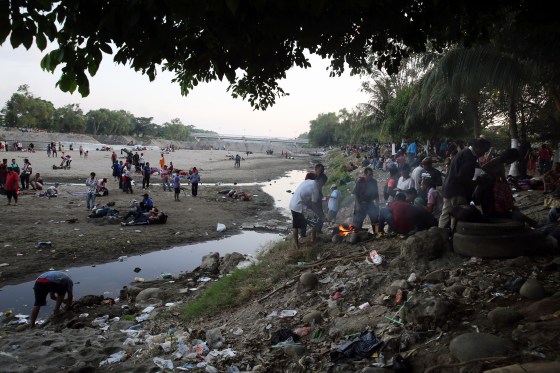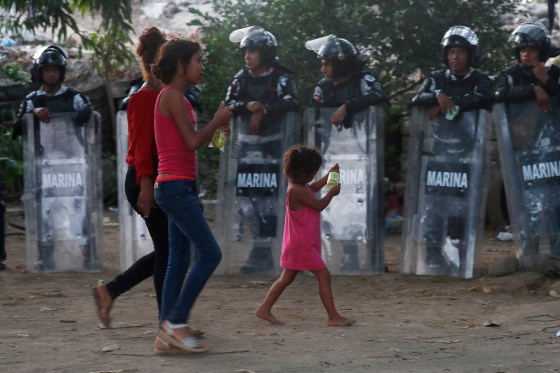(CIUDAD HIDALGO, Mexico) — Hundreds of Central American migrants were stranded in a sort of no-man’s land on the river border between Guatemala and Mexico after running up against lines of Mexican National Guard troops deployed to keep them from moving en masse into the country and on north toward the U.S.
Naked children played amid the sand and trash Monday evening as clothing and shoes hung from the trees to dry along the Suchiate River, normally a porous waterway plied all day by rafts ferrying people and goods across. Men grilled a fish over a small fire below the border bridge, and migrants bedded down under blankets on the banks or dry sections of the riverbed without knowing what might come next.
The path forward was blocked Monday by Mexican troops with riot shields, and about 100 National Guard agents continued to form a barrier with anti-riot gear into the night. But a return home to impoverished and gang-plagued Honduras, where most of the migrants are from, was unthinkable.
“We are in no-man’s land,” said Alan Mejía, whose 2-year-old son was cradled in his arms clad only in a diaper as his wife, Ingrid Vanesa Portillo, and their other son, 12, gazed at the riverbanks. Mejía joined in five previous migrant caravans but never made it farther than the Mexican border city of Tijuana.
“They are planning how to clear us out, and here we are without water or food,” said a desperate Portillo. “There is no more hope for going forward.”

Unlike what was often the case with previous caravans, there was no sign of humanitarian aid arriving for those stuck at the river.
Throngs waded across the Suchiate into southern Mexico on Monday hoping to test U.S. President Donald Trump’s strategy to keep Central American migrants away from the U.S. border. The push also challenged Mexico’s ramped-up immigration policing that began last year in response to threats of economic tariffs from Trump, a change that effectively snuffed out the last caravan in April.
Some scuffled with National Guard troops on the riverbank while others slipped through the lines and trudged off on a rural highway, with most taken into custody later in the day. Still others were taken into custody on the spot or chased into the brush. Some migrants hurled rocks at the police, who huddled behind their plastic shields and threw some of the rocks back.
Most of the migrants, however, stayed at the river’s edge or stood in its waters trying to decide their next move after being blocked earlier in the day from crossing the bridge linking Tecun Uman, Guatemala, with Ciudad Hidalgo, Mexico.
“We never thought they would receive us like that,” said Melisa Ávila, who traveled from the Honduran capital of Tegucigalpa with her 12-year-old son and was resigning herself to the prospect of spending the night outdoors. “They treated us like dogs.”
Read more: The Story of Migration Is More Positive Than We’ve Been Led to Believe
In an approach that developed after the first migrant caravan in late 2018, Mexican officials seem to be succeeding in their effort to blunt large-scale incursions by breaking up the mass of people repeatedly and into increasingly smaller groups. Over the weekend, government officials convinced about 1,000 people they should enter legally via the bridge.
The National Immigration Institute issued a statement saying it would detain any migrants in the country illegally, hold them in detention centers and deport those who did not legalize their status. Any who made it through and continued north could expect a gauntlet of highway checkpoints. As feared, children suffered in the chaos. On the Mexican bank an unconscious 14-year-old girl was carried away for medical attention Monday.
Later along the highway, a mother sobbed after realizing her youngest daughter had been separated when migrants tried to escape authorities. Another migrant who had been helping her by carrying the 5-year-old ran in another direction when the migrants scattered and she hadn’t been able to locate them. Back at the river, Ávila, who had befriended the woman at a shelter in Tecun Uman, walked along the bank showing everyone a picture of the daughter.
“Have you seen this little girl?” Ávila asked other migrants. “Blue pants, beige shirt and little pink shoes.”

The Guatemalan government issued new data saying that 4,000 migrants had entered that country through the two primary crossings used by the migrants last week, and over the weekend nearly 1,700 entered Mexico at two crossings. It said 400 had been deported from Guatemala.
The Immigration Institute said late Monday in a statement that about 500 migrants had entered irregularly and announced the “rescue” of 402 of them — using the term it frequently employs to describe migration detentions; It said the latter were taken to holding centers and offered medical care.
The institute said five National Guard troops were hurt but did not give details.
While Mexico says the migrants are free to enter if they do so through official channels — and could compete for jobs if they want to stay and work — in practice, it has restricted such migrants to the impoverished southernmost states while their cases are processed by a sluggish bureaucracy.
When the rocks began flying at the river Monday, Elena Vásquez, , fearful for the safety of her two wailing sons, bolted back to the Guatemalan side where she would later spend the night. Exhausted after a week on the road, the 28-year-old from Olancho, Honduras, vowed to endure and hoped Mexican authorities would have a change of heart.
“I am going to wait as long as necessary. God will open the gates for us,” Vásquez said. “Necessity forces one day more on us,” she continued. “We will have to wait and see what happens.”
___
Associated Press writer María Verza reported this story in Ciudad Hidalgo, Mexico, and AP writer Sonia Pérez D. reported from Tecun Uman, Guatemala.
